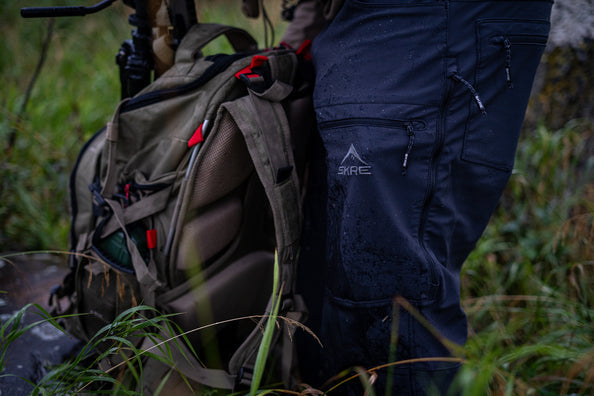Packing and Preparing for an Elk Hunting Trip: A Comprehensive Guide
Sep 12, 2024
The cool autumn air was crisp and the aroma of sage and aspen lingered in the light breeze as I ascended the faint mountain trail leading to this high mountain park surrounded by a dense tangle of aspen and fir. The elk love this park because a generation of beavers dammed the small creek meandering through it allowing water to reach the far corners of the meadow. I’m doubtful the beavers intended to create a fertile environment where a multitude of grasses and forbes thrive, but that is exactly what they did. As I approached within 100 yards of the park, I paused to check the wind and adjust my pack. As I started back up the trail the autumn silence was broken by the raspy bugle of a mature herd bull that was wreaking havoc near the beaver dams. That sound in the pre-dawn light is exhilarating. I’m not sure there is anything more thrilling than hearing the nearby bugle of a rut crazed bull. It’s one reason I love to hunt these majestic animals. Embarking on an elk hunting trip in the wild west is the epitome of outdoor adventure. The thrill of the hunt, the challenge of big dangerous wilderness country, and the serene beauty of the mountains all combine to create an unforgettable experience. However, the success of such an adventure hinges significantly on meticulous packing and preparation. This article will guide you through the essentials of packing and preparing for an elk hunt, ensuring you’re ready to handle the challenges and maximize your chances for success. Ultimately the purpose of this article is to gear you up for success.
Get ready for Elk Season with SKRE Gear
SKRE Gear® offers everything you need for your hunt. A variety of base layers and other gear to choose from to help you stay comfortable during the entirety of your hunt.
Shop Gear for Elk Hunters
Planning Your Hunt
Research Your Destination
Before you start packing, thorough research about the country you're hunting is crucial. Conditions in the Rocky Mountains can change quickly. Elk live in big

steep country, and elk don’t care about weather, or if hunters are in good enough shape to conquer the terrain they live in. Understanding the terrain, weather conditions, and local wildlife regulations will put you in a much better position to punch that tag. This knowledge will help you tailor your gear and strategy to fit the specific conditions you’ll encounter.
- Terrain: Western elk hunting often involves diverse landscapes, from mountainous rocky terrain to dense forests of aspen and fir. Knowing the terrain will influence the type of gear you need.
- Weather: Weather in the West can be unpredictable. Research historical weather patterns for the time of year you’ll be hunting to prepare for temperature fluctuations, rain, or snow. Preparing for the warmest of temperatures and the coldest of temperatures will be critical to your success. My philosophy when it comes to gear for an elk hunt is, its better to have it and not need it than need it and not have it.
- Regulations: Familiarize yourself with local hunting regulations, including permit requirements, hunting seasons, and specific rules related to the area. For example, often hunters get themselves in trouble over violations that can be prevented by reading and understanding the regulations of the state you will be hunting in. A common mistake hunters make is not keeping the evidence of sex attached to an elk quarter. You must understand and know this before the field butchering process begins
Setting Goals and Expectations
Define what you hope to achieve during your hunt. For many the goal is to punch a tag and fill the freezer, while others have trophy aspirations. The key here is not to forget that hunting is supposed to be a fun adventure. Setting realistic goals and expectations will help guide your preparation and packing decisions and ultimately lead to a satisfying trip filled with memories and hopefully a freezer full of lean clean protein.
Packing Essentials
Clothing
Proper clothing is vital for comfort and functionality during your hunt. A well-thought-out layering system is key. Heavy cumbersome clothing is not practical for elk hunters. A hunter must have the ability to add lightweight layers when it gets

cold and remove layers when the weather warms. I’ve seen it in the 60’s in Colorado in mid-November and I’ve also hunted in a foot of snow at the same time of year. Be prepared for any type of weather. Seems like a simple concept, but one that is often overlooked. A layering system can be divided into 4 different layers: 1) Base Layers also referred to as next to skin layers 2) Insulation Layers 3) Out Layers 4) Waterproof Shell also referred to as Rain Gear
Base Layer
- Purpose: Wicks moisture away from your skin to keep you dry and warm.
- Material: Merino wool or synthetic fabrics like polyester.
- Features: Moisture-wicking, quick-drying, and anti-odor properties.
- Recommendation: SKRE Kaibab Merino Base Layers
Mid Layer
-
Purpose: Provides insulation to retain body heat.

- Material: Fleece, down, or synthetic insulation.
- Features: Breathable, lightweight, and effective at trapping heat.
- Recommendation: SKRE Ptarmigan 850 Down Jacket & Pants
Outer Layer
- Purpose: Protects against wind, rain, and snow.
- Material: Waterproof membranes, softshell fabrics.
- Features: Adjustable cuffs, hoods, and ventilation zippers.
- Recommendation: SKRE Hardscrabble Jacket & Pant
Footwear
- Boots: Waterproof, insulated, and providing good ankle support and traction.
- Socks: Moisture-wicking, breathable, and durable.
- Recommendation: Crispi Nevada insulated
Accessories
- Gloves: Warm yet dexterous, with removable liners if possible.
- Hat/Beanie: Warm for cold conditions, lightweight for warmer weather.
- Neck Gaiter: Provides additional warmth and protection.
- Recommendation: SKRE Deadfall gloves, Ibex Merino Beanie, Ibex Merino neck gaiter
Get Ready for Elk Season with SKRE Gear
SKRE Gear® offers everything you need for your hunt. A variety of base layers and other gear to choose from to help you stay comfortable during the entirety of your hunt.
Shop Gear for Elk Hunters
Hunting Gear
Weapons and Ammunition
- Rifle: Choose a reliable, accurate rifle suitable for long-range shooting. Popular calibers include 300 PRC, 28 Nosler, 300 Win Mag, 7mm, and the trusty old 30.06. Elk are tough so use calibers that hit hard and use bullets preferably with a solid core. I personally shoot a 6.5 PRC but many would argue that caliber is too light for elk. Tell that to all the elk that have fallen to this caliber. Practice and proficiency are far more important than caliber.
- Bow: For archery hunters, a compound bow with a draw weight of 60-70 pounds is recommended. Bows are shooting faster and with more accuracy than ever before and frankly, there are too many options to list. Elk don’t give a dam how much you spent on your bow and what brand or model you are shooting. Purchase a bow you can afford and can shoot with accuracy.
- Ammunition: Bring plenty of ammunition, considering your rifles or bow’s specific requirements. Another reminder that should not be included in this article, but it’s here for a reason.
Optics
- Binoculars: High-quality binoculars (10x42 magnification) for spotting elk from a distance.
- Scope: A reliable scope with adjustable magnification for accurate long-distance shooting.
- Recommendation: Vortex Viper and Razor series of optics are incredible

Navigation Tools
- GPS: A reliable GPS device to navigate the terrain.
- Map and Compass: Always carry a physical map and compass as a backup to electronic navigation tools.
- Recommendation: Garmin
Survival Gear
- First Aid Kit: A comprehensive first aid kit for emergencies.
- Multi-tool: A versatile multi-tool for various tasks.
- Fire-starting Kit: Waterproof matches, a lighter, or a fire starter.
- Recommendation: Homemade First Aid kit, Leatherman multitool, Bic lighter and tinder quick fire starter
Field Dressing Kit
- Knife: A sharp, durable hunting knife for field dressing.
- Bone Saw: A compact bone saw for processing large animals.
- Game Bags: To keep meat clean and cool.
- Recommendation: Havalon Knives, Gerber bone saw, Caribou game bags
Camping Gear
- Tent: A durable, weather-resistant tent suitable for the conditions.
- Sleeping Bag: A sleeping bag rated for the temperatures you expect.
- Sleeping Pad: Provides insulation and comfort while sleeping.
- Recommendations: Western Mountaineering Sleeping bags, Therma rest sleeping pads, Seek Outside Tepee Tents
Food and Water
- Food: Non-perishable, high-energy foods like trail mix, energy bars, and dehydrated meals.
- Water: Hydration systems or water bottles. Consider a portable water filter if you’re accessing natural water sources.
- Recommendation: Platypus and MSR filtering systems, food high in protein

Backpack
When it comes to a good backpack the number one consideration should be weight distribution and durability. A lightweight pack with poor weight distribution will result in a sore back and an uncomfortable experience. The best way to select a good pack is to load 50 lbs of weight in the pack. Once all the straps are adjusted and the load lifters are set the weight should feel closer to 35 lbs. than 50 lbs. The second consideration should be given to the accessibility of gear. I like a pack with some compartmentalization to keep things organized and quickly accessible. I like a pack that has a load shelf so elk quarters can be secured tight against your back for the ultimate weight distribution.
Recommendation: SKRE Ridgeline 5000 Frame Pack
Preparing for the Hunt
Physical Conditioning
Elk hunting often involves navigating rugged terrain and tackling steep ascents, so physical conditioning is essential. I’m not suggesting you need to have a gym membership, but being in good shape, however you get there, is going to allow you to have a much more enjoyable hunting experience. Below is a list of my personal recommendations.
- Cardiovascular Fitness: Incorporate activities like running, hiking, or cycling to build endurance. Incorporate a pack with some weight into your cardio.
- Strength Training: Focus on building leg and core strength to handle steep climbs and heavy packs.
-
Practice: Regularly practice shooting at various distances to ensure
accuracy with your weapon.
Scouting and Research
Pre-Season Scouting
- Spotting: Use binoculars or a spotting scope to locate elk trails, feeding areas, and bedding sites. Can’t stress enough- let your eyes do the walking. Aimlessly hiking around is going to wear you out quickly.
-
Trail Cameras: Set up trail cameras, where legal, to monitor elk activity and identify the best spots for hunting.

Understanding Elk Behavior
- Rut Season: During the rut, bulls are more vocal and aggressive. Use this to your advantage with calling techniques. There are lots of good articles and how to videos on this so I will not attempt to cover it here.
- Feeding and Bedding: Learn where elk feed and bed to increase your chances of locating them
Permits and Licensing
Ensure you have all the necessary permits and licenses required for your hunting area. Verify deadlines and application processes well in advance. Can’t stress this enough. Don’t let your hunt get ruined by violations. It’s your responsibility to know the law and follow it.
Get Ready for Elk Season with SKRE Gear
SKRE Gear® offers everything you need for your hunt. A variety of base layers and other gear to choose from to help you stay comfortable during the entirety of your hunt.
Shop Gear for Elk Hunters
Safety Considerations
Hunter Safety
- Visibility: Wear high-visibility clothing or blaze orange to avoid citations & accidents. Wearing a specific amount of blaze orange is a law in most states, and make no mistake they will ticket you if you are not in compliance.
- Identify Your Target: Always be sure of your target and what lies beyond it before shooting. I shouldn’t have to include this in this article but if it saves a life its worth it. Seems like annually we have accidents that could have been prevented if hunters always identified their target.
- Recommendation: SKRE Hardscrabble Vest
Wildlife Encounters
- Bear Safety: In bear country, carry bear spray and make noise to avoid surprising a bear. In some places like Colorado and other states, it’s a law that you must carry bear spray. The bear populations in the west and therefore bear/human encounters are on the rise so be prepared to deal with bears.
- Elk Behavior: Maintain a safe distance from elk, especially during the rut when they can be more aggressive.
Environmental Responsibility

-
Leave No Trace: Follow the principles of Leave No Trace by packing out all trash and minimizing your impact on the environment. Sadly, there are a few irresponsible hunters who can't pick up after themselves, and hence tarnishes the image of the hunting community as a whole.
-
Respect Wildlife: Adhere to ethical hunting practices and respect the wildlife you are pursuing. Fair Chase is the only way to hunt and is part of our unwritten creed as hunters.
Final Preparations
Packing Your Gear
- Organize: Pack your gear systematically, ensuring that essential items are easily accessible. Use gear-specific bags or compartments to keep everything organized.
- Weight Distribution: Distribute weight evenly in your pack to maintain balance and reduce strain on your back.
- Recommendation: Granite Gear Air Zipditty
Pre-Hunt Checklist
- Gear Check: Verify that all your gear is in working order. Check your rifle or bow, optics, and other equipment. You don’t need to be miles from the truck only to discover a piece of gear is inoperable.
- Weather Assessment: Check the weather forecast again to make any last-minute adjustments to your clothing and gear.
Communication
- Emergency Contacts: Inform someone about your hunting plans, including your expected return time and location.
- Communication Devices: Ensure you have a reliable way to communicate in case of emergencies, such as a satellite phone or radio.
Conclusion
Packing and preparing for an elk hunting trip requires careful planning and attention to detail. I’m OCD when it comes to pre-hunt preparation. I have too much invested in my hunting trips not to adequately prepare. By understanding the terrain, selecting the right clothing and gear, and ensuring you are physically and mentally prepared, you set yourself up for a successful and enjoyable hunt. Remember, preparation is not just about packing the right items but also about understanding the environment and conditions you’ll be facing. Practicing with your weapon of choice. The list is fairly long, however, with the right approach, your elk hunting adventure will be a rewarding and memorable experience, blending the thrill of the hunt with the beauty of the wilderness these magnificent animals call home.
Published: 9/13/2024



